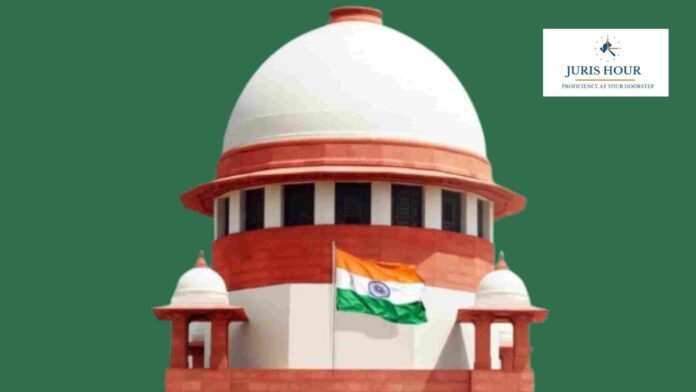The Supreme Court overturned the Bombay High Court decision which permitted the defence without leave of the court in summary suit under order 37 of the Code of Civil Procedure.
The Division bench of Justice Ahsanuddin Amanullah and Justice S.V.N. Bhatt viewed that the order passed by the Bombay High Court needs to be interfered with in as much as if a reply or defence is allowed to come on record in a summary suit without the Leave of the Court then the distinction sought to be maintained between a Suit normally instituted and Summary Suit under Order XXXVII of the CPC stands effaced.
Background
The parties to the civil appeal had business transactions for reasonably good time. The present Commercial Suit is filed to recover the alleged admitted and confirmed total liability together with interest at 24% per annum.
The suit was filed under Order XXXVII of the Civil Procedure Code, 1908 (‘the CPC’). Summons were issued along with the Plaint and Annexures, which have been stated as served on the Defendants, the Defendant entered appearance in terms of sub-Rule (3) of Rule 3 of Order XXXVII of the CPC.
The Plaintiff filed Summons for Judgment No. 75 of 2021 in Commercial Summary Suit No. 19 of 2020. The Plaintiff alleged that the Summons for Judgment No. 75 of 2021 was served on the Defendant on 11.01.2022.
According to the plaintiff, the Defendant ought to have, if advised, filed for leave to defend by disclosing the defence available against the claim in the Summary Suit.
Submissions
Advocate for Plaintiff contended that the step ordered by the High Court, allowing reply to the Summons for Judgment, is procedurally incorrect and unsustainable. The requirement in terms of sub-Rule (5) of Rule 3 of Order XXXVII of the CPC is to file an application seeking leave to file the defence. In the application filed praying for leave, the court decides whether a case for granting leave to defend is made out or not, considering the nature of the recovery.
Advocate Sanampreet Singh, appearing for the Defendant, contended that the Application seeking condonation of delay is pending. Even if the application is under a wrong provision, the same is not a ground to assume that the Plaintiff is entitled to a decree.
Further, it was argued that the delay stated by the Plaintiff in filing the application is not correct, as it is always available to the Defendant to convince the court either to grant leave or condone the delay.
He argued that the delay in filing the application, as stated by the Plaintiff, is factually incorrect.
Observation
The court noted that the precise question is whether the court could have permitted filing a reply/defence without even praying for leave, setting out the available defence, etc.
The bench observed that admittedly, instead of filing an Application seeking leave to defend, the Defendant filed an I.A. praying for the dismissal of the suit for non-compliance with Section 12A of the Commercial Courts Act. The application was allowed, the parties were referred to mediation, and the Summary Suit was kept in abeyance. The Mediation Report was filed by the Mediator. The I.A. was filed to allow the Plaintiff to amend the plaint and summons for judgment as per the Schedule annexed, and the same was allowed by order.
The bench further observed that the procedural objection as pointed out by the Plaintiff, the sequence of steps under Order XXXVII Rule 3 sub-Rules (1) to (7) of the CPC is set out as
- On filing the Summary Suit, the plaintiff must serve the defendant with the plaint and annexures, together with the summons.
- The defendant has ten days to enter an appearance, in person or through a pleader, and provide a service address. On the same day, the defendant must notify the plaintiff or its pleader of its appearance.
- The plaintiff then serves a summons for judgment on the defendant in the court-prescribed format, supported by an affidavit verifying the cause of action, the amount claimed, and the belief that the defendant has no defence.
- Thereafter, the defendant has ten days to apply for leave to defend by filing an affidavit disclosing a genuine and substantial defence. The court may grant leave to defend unconditionally or on such terms that may appear to be just.
- The court shall not refuse leave unless the defence is frivolous or vexatious. Further, if the defendant admits to owing part of the amount, it must deposit that amount in court to get the leave to defend.
- If the defendant does not apply for leave or its application seeking leave is refused, the plaintiff is entitled to immediate judgment. If the court grants leave to defend but the defendant fails to comply with any condition or other directions, the plaintiff is also entitled to immediate judgment.
- The court has the discretion to condone any delay in entering an appearance or applying for leave to defend if the defendant shows sufficient cause.
The court stated that after perusing the record and also the step taken by the High Court in bypassing the requirement of sub-Rules (4) and (5) of Rule 3 of Order XXXVII of the CPC, the procedural deviation goes to the root of the matter.
The bench set aside the order and directed that the setting aside of the order shall not be understood as foreclosing the options available to the Defendant in the Judgment Summons already issued, or the observations made in the present order shall not prejudice the case of either party.
Case Details
Case title: Executive Trading Company Private Limited. Versus Grow Well Mercantile Private Limited
Citation: SLP (C) NO. 1134 OF 2024
Counsel for the Appellant: Debesh Panda
Counsel for the Defendant: Sanampreet Singh
Date: September 25, 2025

